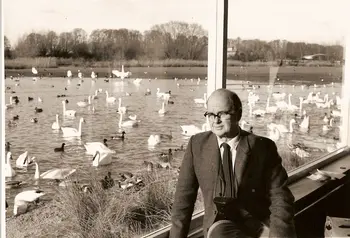Wildfowl and Wetland Trust to tell story of Sir Peter Scott thanks to National Lottery

Sir Peter's home at Slimbridge Wetland Centre in Gloucestershire was the site of the BBC’s first-ever natural history programme. Sir Peter presented the show live from his studio lounge in May 1953.
HIs pioneering television career in the 1950s inspired many broadcasters, including Sir David Attenborough, who commented: "Peter is and always will be the patron saint of conservation. Long before words like ‘biodiversity’ were coined, Peter looked out from that huge window in his house at Slimbridge and realised our lives are so linked with our natural world that we have to learn to love it and look after it. I think it’s wonderful that absolutely anyone will be able to sit in that same window in future years and feel just as inspired.”
The house is also a key part of the story of modern conservation – the global system for designating species as threatened, endangered or extinct was largely devised there by Scott as he helped to found the Wildfowl & Wetland Trust (WWT), the World Wildlife Fund (WWF), IUCN Species Survival Commission and other organisations that have prevented many animals from going extinct.
HLF’s grant will help renovate the house and enable the public to experience the fascinating history within it. The Scott Tour will continue out into the grounds, among the world’s biggest collection of water birds including the Hawaiian goose, which Scott saved from extinction. There will be new attractions including an aviary and theatre, more hides overlooking the wild nature reserves and access to WWT’s world-renowned conservation breeding duckery.
Environment Minister Rory Stewart said: “The Wildfowl and Wetland Trust do really important work looking after our landscapes and wildlife, and I’m delighted HLF is supporting the Trust to honour the memory of the great Sir Peter Scott. Sir Peter changed the way we think about conservation and the new centre at Slimbridge will bring his legacy to life and continue the truly excellent work already underway to protect our wildlife.”
HLF Trustee Jim Dixon said: “Sir Peter Scott inspired a generation of conservationists across the world. His studies on the migration of wildfowl made him a firm believer in working across national boundaries for conservation. I can’t think of a more fitting way to use National Lottery players’ money than by marking his global reputation and giving Slimbridge a renewed role to celebrate the work he pioneered and loved.”
HLF has awarded an initial £360,000 to help WWT develop plans for the new heritage tour of Slimbridge Wetland Centre, starting from Scott’s house. In addition to HLF’s full £4.4m grant, WWT will need to raise a further £1.6m towards the full £6m project cost.
WWT Chief Executive Martin Spray CBE said: “We want everyone in the area to feel proud of how important Slimbridge is to wildlife conservation across the world, and to enjoy getting close to wildlife in a beautiful, watery landscape. We’re inviting local people to be part of sharing that pride, and to inspire the young conservationists of tomorrow.”
Notes to editors
- Sir Peter was the only child of Antarctic explorer Captain Scott, who famously instructed his wife to “make the boy interested in natural history”
He was named after Peter Pan – his godfather was author JM Barrie - A famous broadcaster, Sir Peter commentated on television broadcast of the Coronation of Queen Elizabeth II. He presented many radio programmes including Nature Parliament in the 1940s, and presented the first BBC nature television programme Look from 1955 to 1981, including the first BBC wildlife documentary filmed in colour in 1963
- SIr Peter was an artist and inventor. He invented the trapeze that racing crews use to hang from a sailing boat, the rocket net which catches birds, and he helped design the camouflage used by British Second World War warships. His best-known painting, Taking to Wing, was printed 350,000 times as a picture or on Christmas cards and table mats
- Sir Peter was the first person to be knighted for services to conservation, in 1973. As well as being a founder of WWT and WWF, he drew their respective swan and panda logos
He was also a sportsman. Sir Peter was British gliding champion, won a bronze Olympic medal for sailing and was a National Championship-standard ice skater - Sir Peter was taken ill at Slimbridge in 1989, and died in hospital in Bristol. Slimbridge was the blueprint for wetland centres across the UK and the world. Peter saw eight of WWT’s nine wetland centres open before he died. He left a part-finished painting of what the final wetland centre in London would look like, which still sits on the easel in his studio lounge
Further information
- HLF press office: Katie Owen on tel: 020 7591 6036, or Rebecca Lamm on tel: 020 7591 6027 or 07973 613820
- WWTL Peter Morris on tel: 07920 151022
